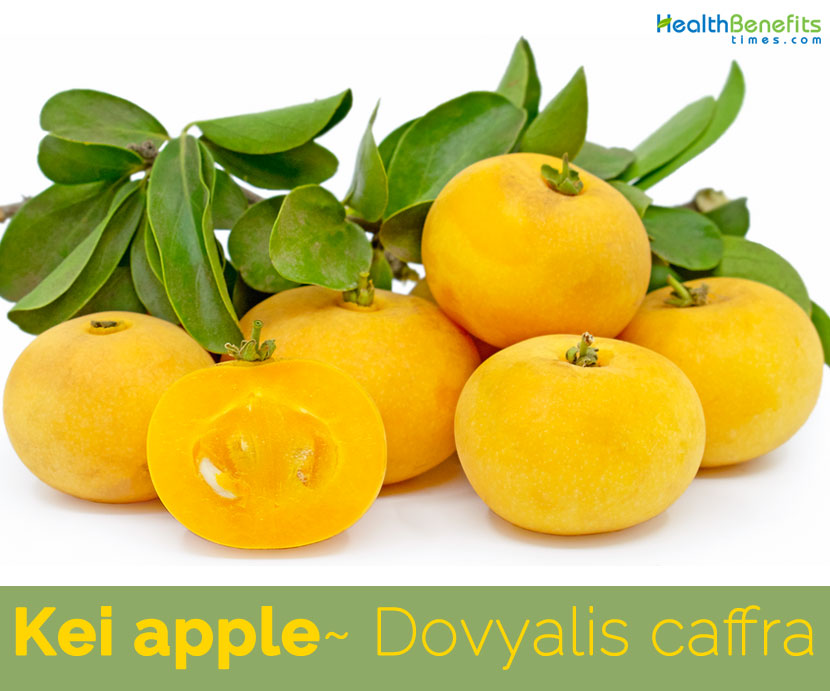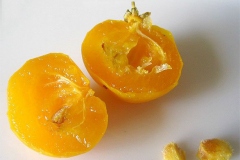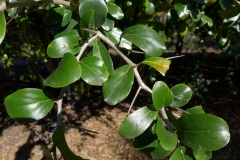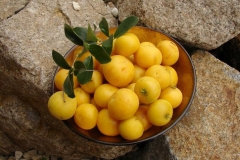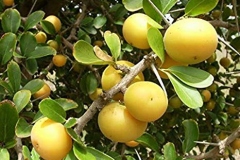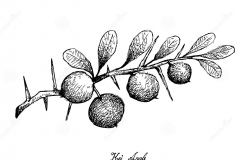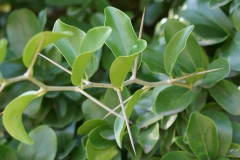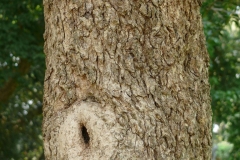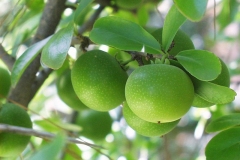| Kei apple Quick Facts | |
|---|---|
| Name: | Kei apple |
| Scientific Name: | Dovyalis caffra |
| Origin | Southern region of Africa including Malawi, Mozambique, Swaziland and Zimbabwe |
| Colors | Turns from green to yellow-orange with a velvety surface when ripe |
| Shapes | Fleshy fruit almost spherical and up to 6 cm in diameter |
| Taste | Tasty, reminiscent of a small apple |
| Name | Kei apple |
|---|---|
| Scientific Name | Dovyalis caffra |
| Native | Southern region of Africa including Malawi, Mozambique, Swaziland and Zimbabwe |
| Common Names | Kei apple, Putukila, Umqokolo, kau apple, Wild Apricot, Kai apple |
| Name in Other Languages | Afrikaans: Kei-appel Arabic: Ramihat janub ‘afriqia ( رامحة جنوب أفريقية) Dutch: Kei-appel English: Kei apple, Putukila, Umqokolo, kau apple, Wild Apricot, Kai apple German: Keiapfel Japanese: Keiappuru (ケイアップル) Philippines: Umkolo Russian: Kafrskaya sliva (Кафрская слива) Shona: Munhungura, Munhunguru, Musvisvirondo, Mutsvoritoto, Mutsvoritsvoto Spanish: Manzana cafre, umkokolo Swahili: Umkokolo |
| Plant Growth Habit | Spiny, attractive, evergreen small to medium-sized shrub or small tree |
| Growing Climates | Occurs in open bush, wooded grassland, mixed scrub, riverine bush, open woodland, forest, valley bushveld, dry areas and on forest edges |
| Soil | Does well in almost any soil that does not have a high water table. It is extremely drought-resistant and tolerates saline soil and salt spray and is accordingly valued as a coastal hedge in the Mediterranean region and in California |
| Plant Size | 30 ft. (9 m) with a spread of 25 ft. (7.5 m) |
| Bark | Smooth bark is grey on young branches, though fissured and flaky to corky on old branches and stems |
| Branches | Young branches are heavily armed with long (4-7 cm) spines, but the stem has few spines |
| Leaf | Simple leaves occur in tight clusters on dwarf lateral branches and alternate on young shoots. Each leaf is obovate 2-5.5 cm by 0.5-3 cm with a rounded apex and tapering base on 5 mm-long petioles |
| Flower | Small creamish-green flowers occur in dense clusters. The male flowers are 3 mm long in dense clusters of five to 10, while the female flowers are solitary or occur in groups of up to three on stalks 4-10 mm long in the leaf axils |
| Fruit Shape & Size | Fleshy fruit is almost spherical and up to 6 cm in diameter |
| Fruit Color | Skin turns from green to yellow-orange with a velvety surface when ripe |
| Propagation | By seed or cuttings |
| Taste | Tasty, reminiscent of a small apple |
| Season | August to October |
Plant Description
Kei apple is a spiny, attractive, evergreen small to medium-sized shrub or small tree that grows about 30 ft. (9 m) tall with a spread of 25 ft. (7.5 m) and usually has many sharp spines 1 to 3 in (2.5-7.5 cm) long, though it is often entirely spineless if not trimmed. Buds at the base of the spine produce clusters of alternately arranged simple ovate leaves 3–6 cm long. The plant is found growing in open bush, wooded grassland, mixed scrub, riverine bush, open woodland, forest, valley bushveld, dry areas and on forest edges. The plant does best in almost any soil that does not have a high water table. It is extremely drought-resistant and tolerates saline soil and salt spray and is hence valued as a coastal hedge in the Mediterranean region and in California. The smooth bark is grey on young branches, though fissured and flaky to corky on old branches and stems. Young branches are heavily armed with long (4-7 cm) spines, but the stem has few spines.
Leaves often fasciculate on short side-branches; lamina is 2–5.5 cm long and 0.5–2.7 cm wide, narrowly obovate, obovate or obovate-elliptic, apex rounded or retuse, cuneate or narrowly rounded and 3-nerved at the base, margins entire, slightly revolute, venation slightly raised on both sides and very laxly reticulate; petiole up to 5 mm. long.
Flower
The small creamish-green flowers occur in dense clusters. The male flowers are 3 mm long in dense clusters of five to 10, while the female flowers are solitary or occur in groups of up to three on stalks 4-10 mm long in the leaf axils. Flowering normally takes place from
Fruit
Kei apple has a rounded shape and petite size measuring around 6 cm in diameter. When ripe the tough skin of the Kei apple turns from green to yellow-orange and boasts a fuzzy coat, similar to that of a peach. Its flesh is mealy and juicy, like that of an apricot and surrounds two rings of central seeds and can contain anywhere between 5 and 15 seeds total. Its flavor is extremely acidic and for most people needs to be sweetened with sugar prior to consumption. In contrast to its flavor, the Kei apple offers a highly aromatic, sweet aroma when ripe. The tree does not fruit until it is 3 years old. In southern Africa, flowering and fruiting occur from November to January. The flowers are pollinated by insects and fruit take about 4 months to mature.
History
Kei apple tree is native to southwest Africa specifically Namibia and the area around the Kei River, hence its namesake. It first made its way to England in 1838 than from there to Algeria, southern France, northwestern Australia, Jamaica, Egypt, the Philippines, and in the United States to Florida and California. A subtropical plant the Kei apple can be grown as a small tree or a shrub and is commonly planted to form a hedge. The plant thrives in locations above 2,600 feet and thrives in dry, sandy soils. It can be grown in saline rich soil and locations near the ocean where salty air is prevalent and is highly tolerant of drought. The Kei apple plant also is known to produce a biochemical that can inhibit the growth of other nearby plants, an occurrence known as allelopathy, while this is beneficial for weed abatement, care should be taken not to plant it too close to other fruit or vegetable-bearing plants.
Culinary Uses
- Ripe fruit has a pleasant flavor and is rich in vitamin C. They are eaten fresh or made into jelly and jam.
- Kei-apples are often eaten fresh, or sprinkled with sugar to complement their natural acidity.
- Aside from being eaten fresh, the fruit can be made into jam, used in desserts, or pickled (their natural acidity means vinegar is not needed).
Other facts
- In Kenya, it is mostly used for live fences and hedges.
- Plants have dense spiny shoots that make an impermeable barrier.
- If the fruit is soaked in water and allowed to ferment, the liquid drained off has herbicidal properties.
- Wood is white, dense and heavy; usually too small to be of general use.
- Trunk of Dovyalis caffra serves as a good source of hard wood for fuel, house building and furniture making.
- The leaves are often used as fodder and are browsed by antelope.
References:
https://www.itis.gov/servlet/SingleRpt/SingleRpt?search_topic=TSN&search_value=506138#null
https://npgsweb.ars-grin.gov/gringlobal/taxonomydetail.aspx?id=14616
https://www.cabi.org/isc/datasheet/19648
https://plants.usda.gov/core/profile?symbol=DOCA3
https://en.wikipedia.org/wiki/Dovyalis_caffra
http://www.plantsoftheworldonline.org/taxon/urn:lsid:ipni.org:names:111560-1
http://gringlobal.iita.org/gringlobal/taxonomydetail.aspx?id=14616
https://gd.eppo.int/taxon/DOVCA
http://www.theplantlist.org/tpl1.1/record/kew-4776111
https://plants.jstor.org/compilation/Dovyalis.caffra
http://tropical.theferns.info/viewtropical.php?id=Dovyalis+caffra
https://hort.purdue.edu/newcrop/morton/kei_apple_ars.html
http://www.tropicos.org/Name/13200641
https://sl.ku.dk/rapporter/seed-leaflets/filer/dovyalis-caffra-27.pdf


